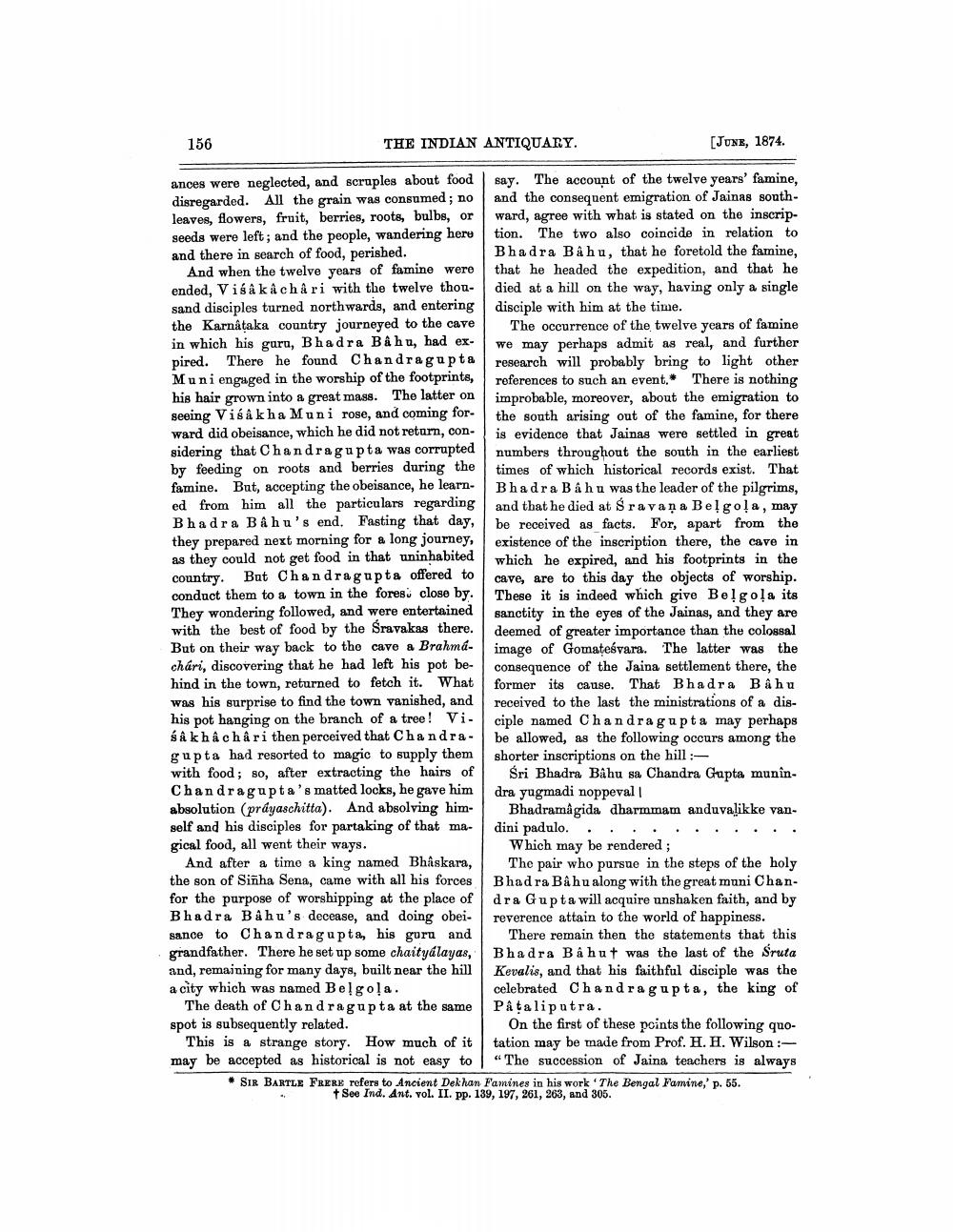________________
156
THE INDIAN ANTIQUARY.
ances were neglected, and scruples about food disregarded. All the grain was consumed; no leaves, flowers, fruit, berries, roots, bulbs, or seeds were left; and the people, wandering here and there in search of food, perished.
And when the twelve years of famine were ended, Vis â kâ châri with the twelve thousand disciples turned northwards, and entering the Karnataka country journeyed to the cave in which his guru, Bhadra Bâhu, had expired. There he found Chandragupta Muni engaged in the worship of the footprints, his hair grown into a great mass. The latter on seeing Visakha Muni rose, and coming for ward did obeisance, which he did not return, considering that Chandragupta was corrupted by feeding on roots and berries during the famine. But, accepting the obeisance, he learned from him all the particulars regarding Bhadra Bahu's end. Fasting that day, they prepared next morning for a long journey, as they could not get food in that uninhabited country. But Chandragupta offered to conduct them to a town in the fores. close by. They wondering followed, and were entertained with the best of food by the Śravakas there. But on their way back to the cave a Brahmachári, discovering that he had left his pot behind in the town, returned to fetch it. What was his surprise to find the town vanished, and his pot hanging on the branch of a tree! Visâkhâchari then perceived that Chandra. gupta had resorted to magic to supply them with food; so, after extracting the hairs of Chandragupta's matted locks, he gave him absolution (prayaschitta). And absolving himself and his disciples for partaking of that magical food, all went their ways.
And after a time a king named Bhaskara, the son of Sinha Sena, came with all his forces for the purpose of worshipping at the place of Bhadra Bâhu's decease, and doing obeisance to Chandragupta, his guru and grandfather. There he set up some chaityalayas, and, remaining for many days, built near the hill a city which was named Belgola.
[JUNE, 1874.
say. The account of the twelve years' famine, and the consequent emigration of Jainas southward, agree with what is stated on the inscription. The two also coincide in relation to Bhadra Bahu, that he foretold the famine, that he headed the expedition, and that he died at a hill on the way, having only a single disciple with him at the time.
This is a strange story. How much of it may be accepted as historical is not easy to
The occurrence of the twelve years of famine we may perhaps admit as real, and further research will probably bring to light other references to such an event. There is nothing improbable, moreover, about the emigration to the south arising out of the famine, for there is evidence that Jainas were settled in great numbers throughout the south in the earliest times of which historical records exist. That Bhadra Bahu was the leader of the pilgrims, and that he died at Sravana Belgola, may be received as facts. For, apart from the existence of the inscription there, the cave in which he expired, and his footprints in the cave, are to this day the objects of worship. These it is indeed which give Belgola its sanctity in the eyes of the Jainas, and they are deemed of greater importance than the colossal image of Gomatesvara. The latter was the consequence of the Jaina settlement there, the former its cause. That Bhadra Bâhu received to the last the ministrations of a disciple named Chandragupta may perhaps be allowed, as the following occurs among the shorter inscriptions on the hill:
Śri Bhadra Bâhu sa Chandra Gupta munîndra yugmadi noppeval |
Bhadramâgida dharmmam anduvalikke vandini padulo.
Which may be rendered;
The pair who pursue in the steps of the holy Bhadra Bâhu along with the great muni Chandra Gupta will acquire unshaken faith, and by reverence attain to the world of happiness.
There remain then the statements that this Bhadra Bâhut was the last of the Śruta Kevalis, and that his faithful disciple was the celebrated Chandragupta, the king of
The death of Chandragupta at the same Pâta liputra. spot is subsequently related.
On the first of these points the following quotation may be made from Prof. H. H. Wilson:"The succession of Jaina teachers is always
* SIR BARTLE FRERE refers to Ancient Dekhan Famines in his work The Bengal Famine,' p. 55. +See Ind. Ant. vol. II. pp. 139, 197, 261, 263, and 305.




